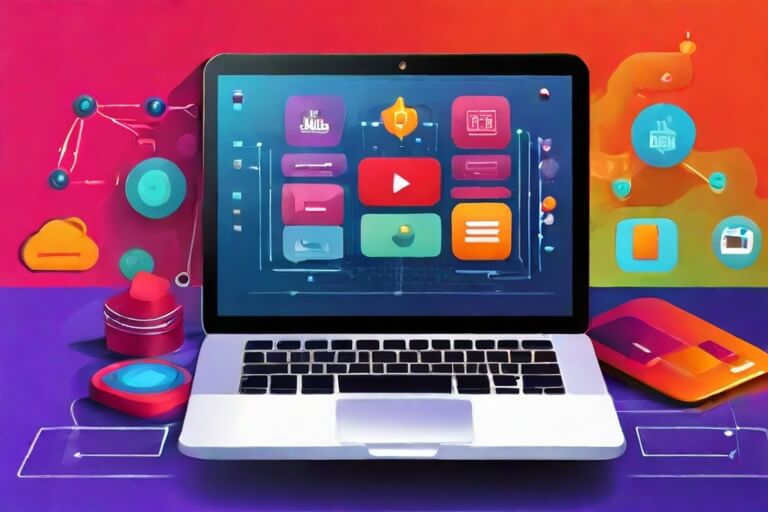TL;DR
- AI-powered chatbots and virtual assistants provide immediate assistance and guidance to users, enhancing the onboarding experience.
- Integration of machine learning algorithms personalizes the onboarding journey based on user preferences and behavior.
- Personalized approach increases user engagement and likelihood of sticking with the product or service.
- AI automates repetitive tasks, such as form filling or account setup, saving time and effort for users.
- AI revolutionizes user onboarding, offering immense potential for businesses to optimize customer acquisition and retention strategies.
In recent years, the process of user onboarding in digital products has undergone a significant evolution. Gone are the days of long and tedious user manuals or complex tutorials to guide users through the initial stages of using a new product. Today, user onboarding has become more streamlined and intuitive, focusing on delivering a seamless and user-friendly experience.
One of the primary drivers of this evolution is the advancements in technology, particularly in the field of artificial intelligence (AI). AI-powered onboarding processes have revolutionized the way users are introduced to digital products. Through the use of intelligent algorithms and machine learning, AI can analyze user behavior and adapt the onboarding experience to match the individual’s needs and preferences. This personalized approach not only enhances user engagement but also improves overall user satisfaction and retention rates.
Enhancing User Onboarding Experiences with Artificial Intelligence
Artificial Intelligence (AI) has become a transformative force in enhancing user onboarding experiences in the digital realm. With its ability to analyze vast amounts of data and learn from user behavior, AI offers unparalleled capabilities to deliver personalized and seamless onboarding journeys. By leveraging AI-powered algorithms, companies can now create tailored onboarding experiences that cater to the unique needs and preferences of individual users.
One way in which AI enhances user onboarding is through intelligent recommendations and predictive guidance. By analyzing user data and patterns, AI algorithms can anticipate user needs and provide relevant suggestions to guide them through the onboarding process. This not only enhances user satisfaction but also increases their engagement with the product or service. Additionally, AI can automate repetitive tasks, such as form filling or data entry, streamlining the onboarding process and reducing the likelihood of user drop-offs. With AI, companies can create onboarding experiences that are efficient, personalized, and effective in driving user adoption and retention.
Understanding the Importance of Seamless Onboarding in the Digital Era
Seamless onboarding has become increasingly crucial in today’s digital era. With the abundance of options available to users, a smooth and hassle-free onboarding experience can make all the difference in capturing and retaining their attention. Digital products that prioritize seamless onboarding understand the importance of creating a positive first impression. By providing users with clear instructions, intuitive interfaces, and personalized experiences right from the start, these products can effectively engage users and encourage them to explore further.
In the digital landscape, where attention spans are short and competition is fierce, a seamless onboarding process can significantly impact user satisfaction and retention. Users are more likely to abandon a product if they encounter obstacles or confusion during the onboarding phase. However, by implementing a well-designed and user-centric onboarding experience, digital products can build trust and establish a strong foundation for continued user engagement. In the coming paragraphs, we will explore the key elements that contribute to seamless onboarding and discuss the challenges that arise in achieving it.
Key Challenges in User Onboarding and How AI Can Address Them
User onboarding has long been recognized as a critical aspect of any digital product or service. However, it is not without its challenges. One of the key challenges in user onboarding is the need to provide a seamless and personalized experience for each individual user. Traditional onboarding processes often rely on manual intervention and may not be able to cater to the specific needs and preferences of users. This is where artificial intelligence (AI) can play a significant role.
AI has the potential to address this challenge by leveraging user data to deliver personalized onboarding experiences. Through machine learning algorithms, AI can analyze user behavior, preferences, and patterns to create customized onboarding journeys. By understanding each user’s unique requirements, AI can guide them through the onboarding process, providing relevant information and guidance at each step. This not only enhances the user experience but also increases the likelihood of successful onboarding and long-term user engagement. AI, thus, offers a solution to the challenge of providing a seamless and personalized onboarding experience in the digital era.
Leveraging AI to Personalize User Onboarding Experiences
In today’s digital era, providing personalized user onboarding experiences has become increasingly important. With the advent of artificial intelligence (AI), businesses now have the opportunity to leverage this technology to create tailored onboarding journeys for their users. AI algorithms can analyze vast amounts of user data, enabling companies to understand individual preferences, needs, and behaviors. This invaluable information allows them to craft personalized onboarding experiences that resonate with users on a deeper level.
By utilizing AI to personalize user onboarding experiences, businesses can enhance customer satisfaction and drive higher engagement rates. Through machine learning algorithms, AI can predict user preferences and deliver targeted content, tutorials, and guidance during the onboarding process. This level of personalization not only helps users get up to speed quickly but also fosters a sense of connection and relevance. Ultimately, personalized onboarding experiences increase the likelihood of user retention and long-term engagement with the product or service.
Streamlining User Onboarding Processes through AI-Driven Automation
The process of onboarding users onto digital platforms has traditionally been time-consuming and resource-intensive. However, with the advent of artificial intelligence (AI), businesses now have the opportunity to streamline this process through automation. By leveraging AI technologies such as machine learning and natural language processing, organizations can significantly reduce the manual effort required for user onboarding while ensuring a seamless and personalized experience for their users.
AI-driven automation can help simplify various stages of the user onboarding process. For instance, through intelligent chatbots, businesses can provide instant assistance to users, answering their queries and guiding them through the registration or setup process. Additionally, AI algorithms can analyze user data to understand individual preferences and behavior, allowing for the automatic customization of onboarding flows to suit each user’s specific needs. This not only saves time for both the business and the user but also enhances the overall onboarding experience, leading to higher user satisfaction and increased conversion rates.
The Role of AI in Improving User Engagement and Retention
AI has revolutionized many aspects of our lives, and it continues to play a crucial role in improving user engagement and retention in digital products. One of the key ways AI enhances user engagement is through personalized recommendations. By analyzing user data, AI algorithms can understand individual preferences and suggest relevant content or features, increasing the likelihood of user engagement. For example, streaming platforms like Netflix use AI to analyze viewing habits and recommend movies or shows based on a user’s interests, resulting in a more tailored and engaging experience.
In addition to personalized recommendations, AI also helps improve user engagement through chatbots and virtual assistants. These intelligent systems can provide real-time assistance and support to users, answering their questions and guiding them through various processes. By offering prompt and accurate responses, AI-powered chatbots enhance user experience and encourage active engagement with the product. Moreover, chatbots can also proactively engage with users, offering relevant information or notifications to ensure users stay engaged and informed.
Overall, AI is proving to be an invaluable tool for improving user engagement and retention. Its ability to provide personalized recommendations and offer real-time assistance significantly enhances the user experience, making it more enjoyable and tailored to individual preferences. As AI technology continues to advance, we can expect even more sophisticated applications that will further improve user engagement and retention in the digital era.
Best Practices for Implementing AI-Enhanced User Onboarding Strategies
Best practices for implementing AI-enhanced user onboarding strategies involve a careful balance between technology and human interaction. While AI can automate certain processes and personalize user experiences, it is crucial to remember that the human element also plays a significant role in creating a seamless onboarding journey.
Firstly, it is important to clearly define the onboarding goals and objectives. This involves understanding the specific needs and pain points of your users, and designing AI-driven solutions that address these challenges effectively. By aligning your AI-enhanced onboarding strategies with the overall business objectives, you can ensure that the implementation is efficient and results-driven. Additionally, leveraging user data and feedback can help fine-tune the AI algorithms, allowing you to continuously improve and refine the onboarding experience for your users.
Case Studies: Successful Examples of AI-Enhanced User Onboarding
During the recent years, AI has proven to be a game-changer for user onboarding in various digital products. One notable case study is the popular music streaming service, Spotify. By leveraging AI technology, Spotify has successfully enhanced its user onboarding process, providing personalized recommendations to new users based on their musical preferences. Through sophisticated algorithms, Spotify’s AI system analyzes user data and behavior, allowing the platform to offer tailored playlists and song suggestions, thereby creating a more engaging and valuable onboarding experience. This AI-driven approach not only helps Spotify attract and retain more users, but also deepens their connection with the platform, leading to higher levels of user satisfaction and loyalty.
Another compelling case study illustrating the effectiveness of AI in user onboarding is the e-commerce giant, Amazon. Through its AI-powered recommendation system, Amazon provides a seamless and personalized shopping experience for its users. By analyzing user behavior, purchase history, and preferences, Amazon’s AI algorithms generate product recommendations that are highly relevant to each individual user. This not only simplifies the onboarding process for new users by reducing the time and effort required to discover products of interest, but also increases overall customer satisfaction and drives repeat purchases. Amazon’s success in leveraging AI for user onboarding showcases the potential of this technology to revolutionize the way businesses onboard and engage with their customers in the digital era.
The Future of AI-Enhanced User Onboarding: Emerging Trends and Opportunities
As the world becomes increasingly digitized, the future of AI-enhanced user onboarding is brimming with exciting possibilities. Emerging trends indicate that artificial intelligence will play a pivotal role in transforming the onboarding process, making it more efficient, personalized, and engaging for users. One prominent trend is the use of AI-powered chatbots and virtual assistants, which can provide immediate assistance and guidance to users, answering their queries and addressing their concerns in real-time. This not only enhances the overall onboarding experience but also reduces the need for human intervention, leading to cost savings and increased scalability for businesses.
Another emerging trend in AI-enhanced user onboarding is the integration of machine learning algorithms to personalize the onboarding journey based on individual user preferences and behavior. By analyzing user data, AI algorithms can identify patterns and provide tailored recommendations and content during the onboarding process. This personalized approach not only makes users feel valued but also increases their engagement and likelihood of sticking with the product or service. Furthermore, AI can also assist in automating repetitive tasks, such as form filling or account setup, allowing users to experience a seamless onboarding process, saving time and effort. With these emerging trends and opportunities, it is evident that AI will continue to revolutionize user onboarding, offering immense potential for businesses to optimize customer acquisition and retention strategies in the digital era.
Frequently Asked Questions
What is user onboarding in digital products?
User onboarding in digital products refers to the process of guiding new users through the initial steps of using a digital product or service. It aims to provide a seamless and intuitive experience for users, helping them understand the features and benefits of the product.
How can artificial intelligence enhance user onboarding experiences?
Artificial intelligence can enhance user onboarding experiences by personalizing the onboarding process, automating certain tasks, and improving user engagement and retention. AI can analyze user data and behavior to provide tailored recommendations and guidance, leading to a more efficient and personalized onboarding experience.
Why is seamless onboarding important in the digital era?
Seamless onboarding is important in the digital era because it significantly impacts user satisfaction, adoption, and retention rates. A smooth onboarding experience reduces friction, helps users quickly understand how to use a product, and increases the likelihood of users becoming long-term customers.
What are the key challenges in user onboarding and how can AI address them?
Key challenges in user onboarding include information overload, lack of personalization, and time-consuming processes. AI can address these challenges by analyzing user data to provide relevant and personalized information, automating onboarding tasks to streamline the process, and offering intelligent guidance to simplify complex features.
How can AI personalize user onboarding experiences?
AI can personalize user onboarding experiences by analyzing user data such as demographics, preferences, and past behavior. This data can enable AI algorithms to provide tailored recommendations, tutorials, and tips that match the individual user’s needs and interests, creating a more personalized and engaging onboarding experience.
How does AI-driven automation streamline user onboarding processes?
AI-driven automation streamlines user onboarding processes by automating repetitive and time-consuming tasks. For example, AI can automatically fill in registration forms, set up user preferences based on analysis of similar users, and provide contextual guidance during the onboarding process, saving time and effort for both users and businesses.
What is the role of AI in improving user engagement and retention?
AI plays a crucial role in improving user engagement and retention by analyzing user behavior, preferences, and feedback. With this information, AI can offer personalized recommendations, suggest relevant features, and provide proactive support, ultimately increasing user satisfaction, engagement, and the likelihood of retaining long-term customers.
What are some best practices for implementing AI-enhanced user onboarding strategies?
Some best practices for implementing AI-enhanced user onboarding strategies include collecting and analyzing user data to understand their needs, personalizing the onboarding experience based on this data, leveraging AI automation to streamline the process, and continuously optimizing the onboarding journey based on user feedback and behavior.
Can you provide some case studies of successful AI-enhanced user onboarding?
Yes, there are several successful examples of AI-enhanced user onboarding. For instance, a digital banking app used AI algorithms to analyze user financial data and provide personalized financial insights during the onboarding process, resulting in increased user engagement and satisfaction. Another example is an e-commerce platform that utilized AI chatbots to guide users through the onboarding steps, answering their questions in real-time and reducing friction.
What are the emerging trends and opportunities for AI-enhanced user onboarding in the future?
The emerging trends and opportunities for AI-enhanced user onboarding include the integration of virtual assistants and chatbots for more interactive onboarding experiences, the use of natural language processing to understand user intent and provide more accurate guidance, and the incorporation of augmented reality or virtual reality to create immersive onboarding experiences. Additionally, AI’s potential to leverage big data and predictive analytics will enable even more personalized and efficient onboarding experiences in the future.




